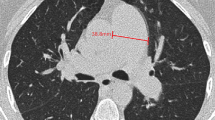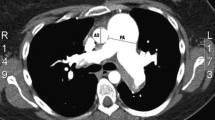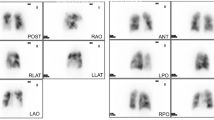Abstract
Objective
To evaluate whether the change in computed tomography pulmonary angiography (CTPA) metrics after balloon pulmonary angioplasty (BPA) can predict treatment effect in chronic thromboembolic pulmonary hypertension (CTEPH) patients.
Methods
This study included 82 CTEPH patients who underwent both CTPA and right heart catheterization (RHC) before and at the scheduled time of 6 months after BPA. The diameters of the main pulmonary artery (dPA), ascending aorta (dAA), right atrium (dRA), right ventricular free wall thickness (dRVW), and right and left ventricles (dRV, dLV) were measured on CTPA. The correlation of the New York Heart Association functional class (NYHA FC), 6-minute walking distance (6MWD), brain natriuretic peptide (BNP) level, and calculated CT metrics with a decrease in mean pulmonary artery pressure (ΔmPAP) using RHC (used as the reference for BPA effect) was investigated. Using multiple regression analysis, independent variables were also identified.
Results
In univariate analysis, clinical indicators (NYHA FC, 6MWD, and BNP level) improved significantly after BPA and were significantly correlated with ΔmPAP (p < 0.01). In the univariate analysis of CTPA parameters, dPA, dRA, dPA/dAA ratio, dRVW, and dRV/dLV ratio decreased significantly and were significantly correlated with ΔmPAP (p < 0.01). Multivariate analysis demonstrated that decreased dPA (p = 0.001) and decreased dRA (p = 0.039) on CTPA were independent predictive factors of ΔmPAP.
Conclusions
Decreased dPA and dRA on CTPA could predict a decrease in mPAP after BPA, thus potentially eliminating unnecessary invasive catheterization.
Key Points
• The reduction in mean pulmonary artery pressure after balloon pulmonary angioplasty in CTEPH patients was significantly correlated with the clinical indices improvement and CTPA parameter decrease.
• The decreased diameter of the main pulmonary artery and the decreased diameter of the right atrium on CTPA were independent predictors of mean pulmonary artery pressure reduction.


Similar content being viewed by others
Abbreviations
- 6MWD:
-
6-minute walking distance
- BMI:
-
Body mass index
- BNP:
-
Brain natriuretic peptide
- BPA:
-
Balloon pulmonary angioplasty
- CIx:
-
Cardiac index
- CO:
-
Cardiac output
- CTEPH:
-
Chronic thromboembolic pulmonary hypertension
- CTPA:
-
Computed tomography pulmonary angiography
- dAA:
-
Diameter of the ascending aorta
- DECT:
-
Dual-energy computed tomography
- dLV:
-
Diameter of the left ventricle
- dPA:
-
Diameter of the main pulmonary artery
- dRA:
-
Diameter of the right atrium
- dRV:
-
Diameter of the right ventricle
- ICC:
-
Intraclass correlation coefficient
- mPAP:
-
Mean pulmonary arterial pressure
- mRAP:
-
Mean right atrial pressure
- NYHA FC:
-
New York Heart Association functional class
- PAH:
-
Pulmonary arterial hypertension
- PAWP:
-
Pulmonary artery wedge pressure
- PEA:
-
Pulmonary thromboendarterectomy
- PVR:
-
Pulmonary vascular resistance
- RHC:
-
Right heart catheterization
- ROI:
-
Region of interest
- sBP/dBP/mBP:
-
Systolic/diastolic/mean blood pressures
- SD:
-
Standard deviation
References
Simonneau G, Gatzoulis MA, Adatia I et al (2013) Updated clinical classification of pulmonary hypertension. J Am Coll Cardiol 62:D34–D41
Riedel M, Stanek V, Widimsky J, Prerovsky I (1982) Longterm follow-up of patients with pulmonary thromboembolism. Late prognosis and evolution of hemodynamic and respiratory data. Chest 81:151–158
Pepke-Zaba J, Delcroix M, Lang I et al (2011) Chronic thromboembolic pulmonary hypertension (CTEPH): results from an international prospective registry. Circulation 124:1973–1981
Kataoka M, Inami T, Kawakami T, Fukuda K, Satoh T (2019) Balloon pulmonary angioplasty (percutaneous transluminal pulmonary angioplasty) for chronic thromboembolic pulmonary hypertension: a Japanese perspective. JACC Cardiovasc Interv 12:1382–1388
Feinstein JA, Goldhaber SZ, Lock JE, Ferndandes SM, Landzberg MJ (2001) Balloon pulmonary angioplasty for treatment of chronic thromboembolic pulmonary hypertension. Circulation 103:10–13
Ogawa A, Satoh T, Fukuda T et al (2017) Balloon pulmonary angioplasty for chronic thromboembolic pulmonary hypertension: results of a multicenter registry. Circ Cardiovasc Qual Outcomes 10(11):e004029
Hoeper MM, Lee SH, Voswinckel R et al (2006) Complications of right heart catheterization procedures in patients with pulmonary hypertension in experienced centers. J Am Coll Cardiol 48:2546–2552
Renapurkar RD, Shrikanthan S, Heresi GA, Lau CT, Gopalan D (2017) Imaging in chronic thromboembolic pulmonary hypertension. J Thorac Imaging 32:71–88
Dournes G, Verdier D, Montaudon M et al (2014) Dual-energy CT perfusion and angiography in chronic thromboembolic pulmonary hypertension: diagnostic accuracy and concordance with radionuclide scintigraphy. Eur Radiol 24:42–51
Ley S, Ley-Zaporozhan J, Pitton MB et al (2012) Diagnostic performance of state-of-the-art imaging techniques for morphological assessment of vascular abnormalities in patients with chronic thromboembolic pulmonary hypertension (CTEPH). Eur Radiol 22:607–616
Liu M, Ma Z, Guo X, Zhang H, Yang Y, Wang C (2011) Computed tomographic pulmonary angiography in the assessment of severity of chronic thromboembolic pulmonary hypertension and right ventricular dysfunction. Eur J Radiol 80:e462–e469
Held M, Kolb P, Grun M et al (2016) Functional characterization of patients with chronic thromboembolic disease. Respiration 91:503–509
Ponikowski P, Voors AA, Anker SD et al (2016) 2016 ESC Guidelines for the diagnosis and treatment of acute and chronic heart failure: the task force for the diagnosis and treatment of acute and chronic heart failure of the European Society of Cardiology (ESC) developed with the special contribution of the Heart Failure Association (HFA) of the ESC. Eur Heart J 37:2129–2200
Yamada Y, Jinzaki M, Hosokawa T et al (2012) Dose reduction in chest CT: comparison of the adaptive iterative dose reduction 3D, adaptive iterative dose reduction, and filtered back projection reconstruction techniques. Eur J Radiol 81:4185–4195
Cynthia McCollough DC, Edyvean S, Geise R et al (2008) The Measurement, Reporting, and Management of Radiation Dose in CT (2008). American association of physicists in medicine AAPM REPORT NO. 96
Ikeda N (2020) Balloon pulmonary angioplasty for chronic thromboembolic pulmonary hypertension. Cardiovasc Interv Ther 35:130–141
Mizoguchi H, Ogawa A, Munemasa M, Mikouchi H, Ito H, Matsubara H (2012) Refined balloon pulmonary angioplasty for inoperable patients with chronic thromboembolic pulmonary hypertension. Circ Cardiovasc Interv 5:748–755
Roller FC, Kriechbaum S, Breithecker A et al (2019) Correlation of native T1 mapping with right ventricular function and pulmonary haemodynamics in patients with chronic thromboembolic pulmonary hypertension before and after balloon pulmonary angioplasty. Eur Radiol 29:1565–1573
Aoki T, Sugimura K, Tatebe S et al (2017) Comprehensive evaluation of the effectiveness and safety of balloon pulmonary angioplasty for inoperable chronic thrombo-embolic pulmonary hypertension: long-term effects and procedure-related complications. Eur Heart J 38:3152–3159
Truong QA, Bhatia HS, Szymonifka J et al (2018) A four-tier classification system of pulmonary artery metrics on computed tomography for the diagnosis and prognosis of pulmonary hypertension. J Cardiovasc Comput Tomogr 12:60–66
Grosse A, Grosse C, Lang I (2018) Evaluation of the CT imaging findings in patients newly diagnosed with chronic thromboembolic pulmonary hypertension. PLoS One 13:e0201468
Leone MB, Giannotta M, Palazzini M et al (2017) A new CT-score as index of hemodynamic changes in patients with chronic thromboembolic pulmonary hypertension. Radiol Med 122:495–504
Delcroix M, Lang I, Pepke-Zaba J et al (2016) Long-term outcome of patients with chronic thromboembolic pulmonary hypertension: results from an international prospective registry. Circulation 133:859–871
Simonneau G, D'Armini AM, Ghofrani HA et al (2016) Predictors of long-term outcomes in patients treated with riociguat for chronic thromboembolic pulmonary hypertension: data from the CHEST-2 open-label, randomised, long-term extension trial. Lancet Respir Med 4:372–380
Saouti N, de Man F, Westerhof N et al (2009) Predictors of mortality in inoperable chronic thromboembolic pulmonary hypertension. Respir Med 103:1013–1019
Ogawa A, Ejiri K, Matsubara H (2014) Long-term patient survival with idiopathic/heritable pulmonary arterial hypertension treated at a single center in Japan. Life Sci 118:414–419
Madani MM, Auger WR, Pretorius V et al (2012) Pulmonary endarterectomy: recent changes in a single institution's experience of more than 2,700 patients. Ann Thorac Surg 94:97–103 discussion 103
Lewczuk J, Piszko P, Jagas J et al (2001) Prognostic factors in medically treated patients with chronic pulmonary embolism. Chest 119:818–823
Miyamoto S, Nagaya N, Satoh T et al (2000) Clinical correlates and prognostic significance of six-minute walk test in patients with primary pulmonary hypertension. Comparison with cardiopulmonary exercise testing. Am J Respir Crit Care Med 161:487–492
Koike H, Sueyoshi E, Sakamoto I, Uetani M, Nakata T, Maemura K (2018) Comparative clinical and predictive value of lung perfusion blood volume CT, lung perfusion SPECT and catheter pulmonary angiography images in patients with chronic thromboembolic pulmonary hypertension before and after balloon pulmonary angioplasty. Eur Radiol 28:5091–5099
Tamura M, Yamada Y, Kawakami T et al (2017) Diagnostic accuracy of lung subtraction iodine mapping CT for the evaluation of pulmonary perfusion in patients with chronic thromboembolic pulmonary hypertension: correlation with perfusion SPECT/CT. Int J Cardiol 243:538–543
Zhai Z, Ota H, Staring M et al (2018) Treatment effect of balloon pulmonary angioplasty in chronic thromboembolic pulmonary hypertension quantified by automatic comparative imaging in computed tomography pulmonary angiography. Invest Radiol 53:286–292
Ng CS, Wells AU, Padley SP (1999) A CT sign of chronic pulmonary arterial hypertension: the ratio of main pulmonary artery to aortic diameter. J Thorac Imaging 14:270–278
Cochran ST, Bomyea K, Sayre JW (2001) Trends in adverse events after IV administration of contrast media. AJR Am J Roentgenol 176:1385–1388
Katayama H, Yamaguchi K, Kozuka T, Takashima T, Seez P, Matsuura K (1990) Adverse reactions to ionic and nonionic contrast media. A report from the Japanese Committee on the Safety of Contrast Media. Radiology 175:621–628
Acknowledgements
The authors would like to acknowledge all of the patients for their willingness to participate in the study. The authors also thank Naomi Tamaki and Kyoko Komatsu for their valuable assistance.
Funding
The authors state that this work has not received any funding.
Author information
Authors and Affiliations
Corresponding authors
Ethics declarations
Guarantor
The scientific guarantor of this publication is Yoshitake Yamada.
Conflict of interest
Masahiro Jinzaki is a recipient of a grant from Canon Medical Systems. However, Canon Medical Systems was not involved in the design and implementation of this study, the collection, analysis, and interpretation of the data, or the preparation, review, and approval of the manuscript.
All other authors are not associated with companies or other entities.
Statistics and biometry
No complex statistical methods were necessary for this paper.
Informed consent
Written informed consent was obtained from all subjects (patients) in this study.
Ethical approval
The study complied with the Declaration of Helsinki, and the protocol for this prospective observational study was approved by the Ethics Committee of our institution (No. 20120224).
Methodology
• retrospective
• observational
• performed at one institution
Additional information
Publisher’s note
Springer Nature remains neutral with regard to jurisdictional claims in published maps and institutional affiliations.
Supplementary Information
ESM 1
(DOCX 16 kb)
Rights and permissions
About this article
Cite this article
Tsukada, J., Yamada, Y., Kawakami, T. et al. Treatment effect prediction using CT after balloon pulmonary angioplasty in chronic thromboembolic pulmonary hypertension. Eur Radiol 31, 5524–5532 (2021). https://doi.org/10.1007/s00330-021-07711-5
Received:
Revised:
Accepted:
Published:
Issue Date:
DOI: https://doi.org/10.1007/s00330-021-07711-5




